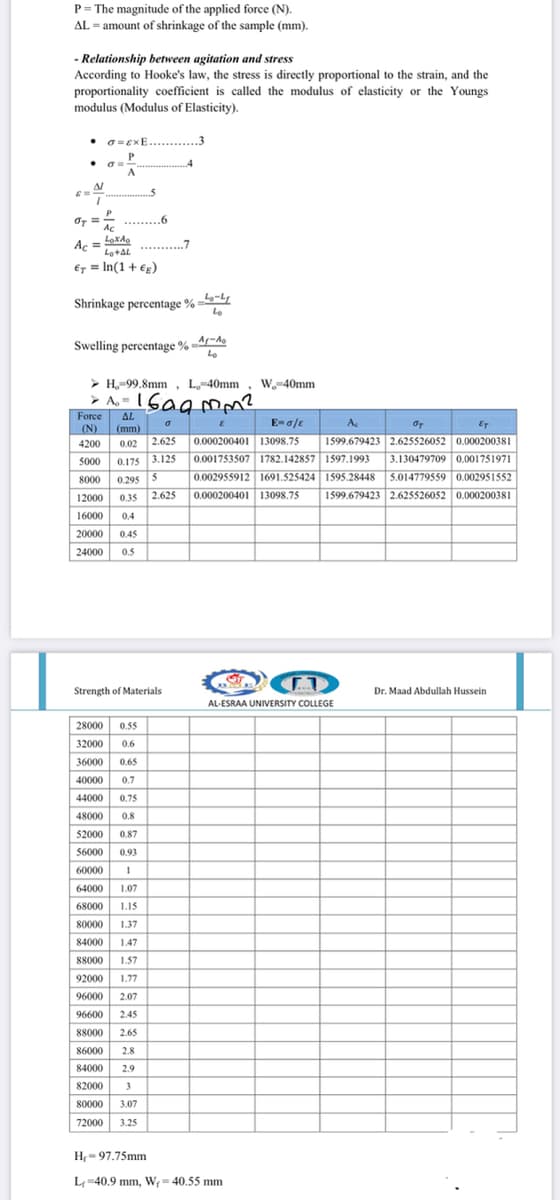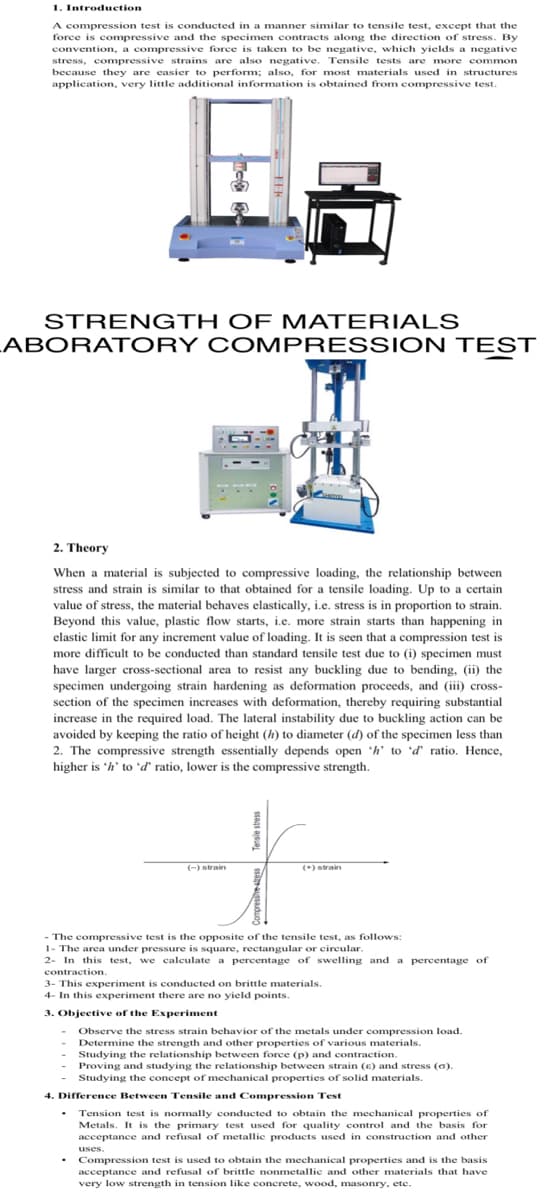P= The magnitude of the applied force (N). AL = amount of shrinkage of the sample (mm). - Relationship between agitation and stress According to Hooke's law, the stress is directly proportional to the strain, and the proportionality coefficient is called the modulus of elasticity or the Youngs modulus (Modulus of Elasticity). • a=exE. P A AC Ac Lotal Er = In(1 + €g) Shrinkage percentage % --4 Swelling percentage % -Ad > H,-99.8mm, L,-40mm , W.-40mm Force (N) AL E-a/e A (mm) 2.625 1599.679423 2.625526052 0.000200381 3.130479709 0.001751971 5.014779559 0.002951552 4200 0.02 0.000200401 13098.75 0.001753507 1782.142857 1597.1993 0.002955912 1691.525424 1595.28448 5000 0.175 3.125 0.295 5 2.625 8000 12000 0.35 0.000200401 13098.75 1599.679423 2.625526052 0.000200381 16000 0.4 20000 0.45 24000 0.5
P= The magnitude of the applied force (N). AL = amount of shrinkage of the sample (mm). - Relationship between agitation and stress According to Hooke's law, the stress is directly proportional to the strain, and the proportionality coefficient is called the modulus of elasticity or the Youngs modulus (Modulus of Elasticity). • a=exE. P A AC Ac Lotal Er = In(1 + €g) Shrinkage percentage % --4 Swelling percentage % -Ad > H,-99.8mm, L,-40mm , W.-40mm Force (N) AL E-a/e A (mm) 2.625 1599.679423 2.625526052 0.000200381 3.130479709 0.001751971 5.014779559 0.002951552 4200 0.02 0.000200401 13098.75 0.001753507 1782.142857 1597.1993 0.002955912 1691.525424 1595.28448 5000 0.175 3.125 0.295 5 2.625 8000 12000 0.35 0.000200401 13098.75 1599.679423 2.625526052 0.000200381 16000 0.4 20000 0.45 24000 0.5
Elements Of Electromagnetics
7th Edition
ISBN:9780190698614
Author:Sadiku, Matthew N. O.
Publisher:Sadiku, Matthew N. O.
ChapterMA: Math Assessment
Section: Chapter Questions
Problem 1.1MA
Related questions
Question
Name of a report STRENGTH OF MATERIALS LABORATORY COMPRESSION TEST Hi sir, I know your precious time will be taken, please get a report. I want you to explain to me one or two pages is enough for me, dear sir, by solving the last schedule, may God help you and grant you God bless you

Transcribed Image Text:P= The magnitude of the applied force (N).
AL = amount of shrinkage of the sample (mm).
- Relationship between agitation and stress
According to Hooke's law, the stress is directly proportional to the strain, and the
proportionality coefficient is called the modulus of elasticity or the Youngs
modulus (Modulus of Elasticity).
•
O =ExE...........3
A
in
..6
......
Ac
LoxAo
Ac
Lo+AL
€r = In(1 + €e)
Shrinkage percentage % --L
Swelling percentage % -d
Lo
> H,-99.8mm , L,-40mm
> A.- 1Gagm?
W.-40mm
Force
AL
E-a/e
A
ET
(N)
(mm)
0.000200401 13098.75
0.001753507 1782.142857 1597.1993
0.002955912 1691.525424 1595.28448
1599.679423 2.625526052 0.000200381
3.130479709 0.001751971
4200
0.02
2.625
5000
0.175 3.125
8000
0.295 5
5.014779559 0.002951552
12000
0.35
2.625
0.000200401 13098.75
1599.679423 2.625526052 0.000200381
16000
0.4
20000 0.45
24000
0.5
Strength of Materials
Dr. Maad Abdullah Hussein
AL-ESRAA UNIVERSITY COLLEGE
28000 0.55
32000
0.6
36000
0.65
40000
0.7
44000
0.75
48000
0.8
52000
0.87
56000
0.93
60000
64000
1.07
68000
1.15
80000
1.37
84000
1.47
88000
1.57
92000
1.77
96000
2.07
96600
2.45
88000
2.65
86000
2.8
84000
2.9
82000
3
80000
3.07
72000
3.25
H- 97.75mm
L-40.9 mm, W- 40.55 mm

Transcribed Image Text:1. Introduction
A compression test is conducted in a manner similar to tensile test, except that the
force is compressive and the specimen contracts along the direction of stress. By
convention, a compressive force is taken to be negative, which yields a negative
stress, compressive strains are also negative. Tensile tests are more common
because they are easier to perform; also, for most materials used in structures
application, very little additional information is obtained from compressive test.
STRENGTH OF M ATERIALS
ABORAT ORY COMPRESSION TEST
2. Theory
When a material is subjected to compressive loading, the relationship between
stress and strain is similar to that obtained for a tensile loading. Up to a certain
value of stress, the material behaves elastically, i.e. stress is in proportion to strain.
Beyond this value, plastic flow starts, i.e. more strain starts than happening in
elastic limit for any increment value of loading. It is seen that a compression test is
more difficult to be conducted than standard tensile test due to (i) specimen must
have larger cross-sectional area to resist any buckling due to bending, (ii) the
specimen undergoing strain hardening as deformation proceeds, and (iii) cross-
section of the specimen increases with deformation, thereby requiring substantial
increase in the required load. The lateral instability due to buckling action can be
avoided by keeping the ratio of height (h) to diameter (d) of the specimen less than
2. The compressive strength essentially depends open h' to d' ratio. Hence,
higher is 'h' to 'd' ratio, lower is the compressive strength.
(-) strain
(*) strain
- The compressive test is the opposite of the tensile test, as follows:
1- The area under pressure is square, rectangular or eircular.
2- In this test, we calculate a percentage of swelling and a percentage of
contraction.
3- This experiment is conducted on brittle materials.
4- In this experiment there are no yield points.
3. Objective of the Experiment
Observe the stress strain behavior of the metals under compression load.
Determine the strength and other properties of various materials.
Studying the relationship between force (p) and contraction.
Proving and studying the relationship between strain (E) and stress (6).
Studying the concept of mechanical properties of solid materials.
4. Difference Between Tensile and Compression Test
Tension test is normally conducted to obtain the mechanical properties of
Metals. It is the primary test used for quality control and the basis for
acceptance and refusal of metallie products used in construction and other
uses.
Compression test is used to obtain the mechanical properties and is the basis
acceptance and refusal of brittle nonmetallic and other materials that have
very low strength in tension like concrete, wood, masonry, etc.
Expert Solution
This question has been solved!
Explore an expertly crafted, step-by-step solution for a thorough understanding of key concepts.
Step by step
Solved in 3 steps

Knowledge Booster
Learn more about
Need a deep-dive on the concept behind this application? Look no further. Learn more about this topic, mechanical-engineering and related others by exploring similar questions and additional content below.Recommended textbooks for you

Elements Of Electromagnetics
Mechanical Engineering
ISBN:
9780190698614
Author:
Sadiku, Matthew N. O.
Publisher:
Oxford University Press

Mechanics of Materials (10th Edition)
Mechanical Engineering
ISBN:
9780134319650
Author:
Russell C. Hibbeler
Publisher:
PEARSON

Thermodynamics: An Engineering Approach
Mechanical Engineering
ISBN:
9781259822674
Author:
Yunus A. Cengel Dr., Michael A. Boles
Publisher:
McGraw-Hill Education

Elements Of Electromagnetics
Mechanical Engineering
ISBN:
9780190698614
Author:
Sadiku, Matthew N. O.
Publisher:
Oxford University Press

Mechanics of Materials (10th Edition)
Mechanical Engineering
ISBN:
9780134319650
Author:
Russell C. Hibbeler
Publisher:
PEARSON

Thermodynamics: An Engineering Approach
Mechanical Engineering
ISBN:
9781259822674
Author:
Yunus A. Cengel Dr., Michael A. Boles
Publisher:
McGraw-Hill Education

Control Systems Engineering
Mechanical Engineering
ISBN:
9781118170519
Author:
Norman S. Nise
Publisher:
WILEY

Mechanics of Materials (MindTap Course List)
Mechanical Engineering
ISBN:
9781337093347
Author:
Barry J. Goodno, James M. Gere
Publisher:
Cengage Learning

Engineering Mechanics: Statics
Mechanical Engineering
ISBN:
9781118807330
Author:
James L. Meriam, L. G. Kraige, J. N. Bolton
Publisher:
WILEY